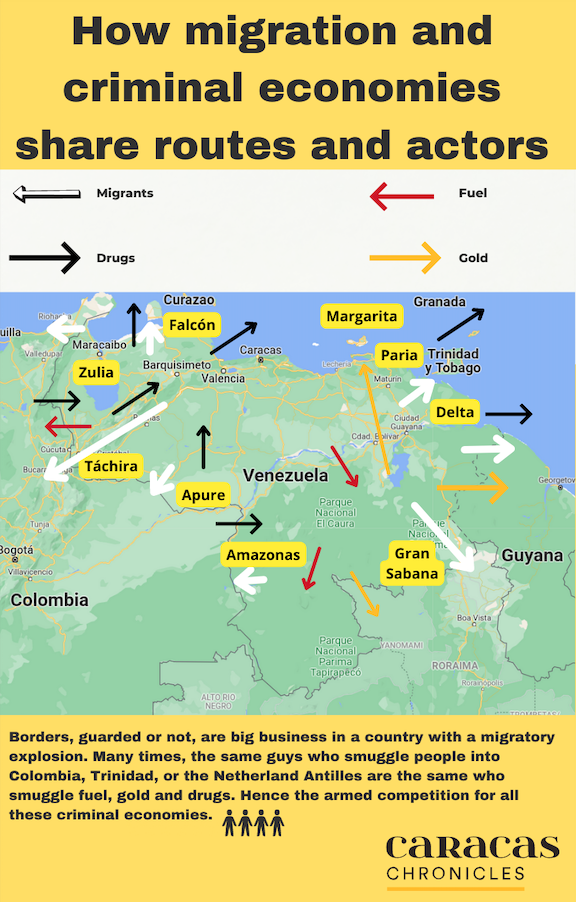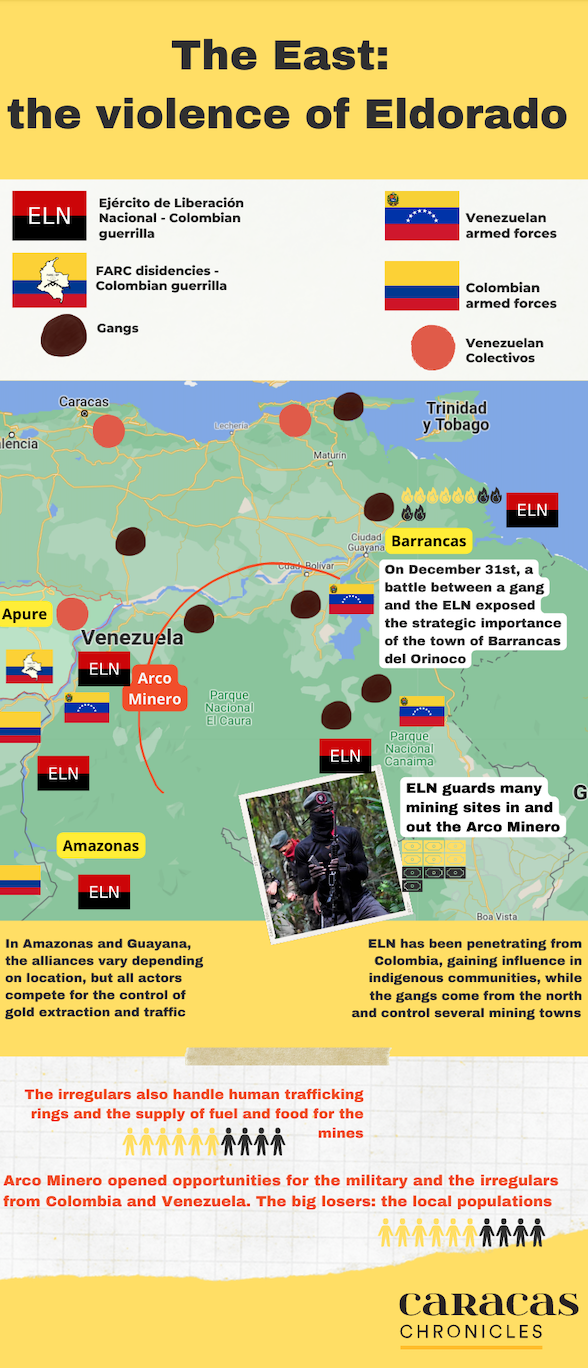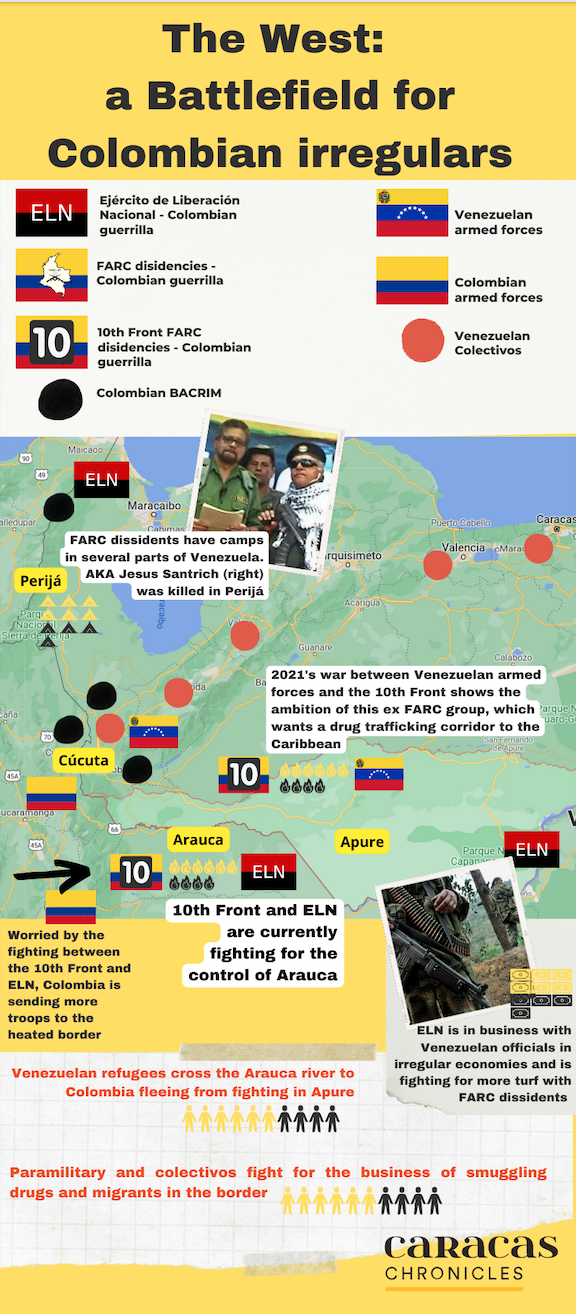Drafting a Basic Map of Armed Actors in Venezuela
Now that news about fighting between guerrillas, gangs, and regular troops are becoming more frequent, we offer three ways of visualizing who are the conflicting groups and what are they fighting for


The following maps were assembled according to what we have gathered from our sources in the Political Risk Report, our own reporting on different conflicts in Venezuela, and what has been reported by Venezuelan and Colombian media or specialized organizations like Insight Crime, the Crisis Group, or Human Rights Watch. Therefore, please take into account:
This is an approximation. Given the elusive nature of irregular armed actors and the opacity of the Maduro regime, it’s hard to know the precise location or even the identity of an armed group in particular. Mafias and guerrillas tend to operate in disguise, even if in the present they have fewer reasons to hide than in the past, now that they act in a territory under a regime that is prone to using irregular actors such as colectivos or unidentified security officers. However, we’re marking the regions where we are sure those actors are, according to several published reports and testimonials.
Consider geography. Venezuela, Colombia, and Brazil share large, scarcely populated territories that are difficult for military surveillance, where it has always been easy for smugglers, fugitives, and irregular armed groups to hide and operate. The plains, the Amazon, and the Orinoco Delta abound in dense forests and navigable rivers that connect the regions where drugs are produced in Colombia with the shores in the Atlantic or the Caribbean that serve to export it to Europe and North America.
Remember history. While Colombia’s armed conflict always had its impact in Venezuela, the current situation is the product not only of the international demand for narcotics and the failure of “war on drugs” policies, but the confluence of two big simultaneous developments. On the Colombian side, the military and paramilitary pressure on the guerrillas followed by the peace process and the demobilization of most factions of FARC but not the ELN. On the Venezuelan side, the collapse of the country’s capacity to preserve sovereignty and order due to the chavista policy of leaving the international security agreements and having the Colombian guerrillas as travel companions while getting involved in innumerable illicit affairs with gangs.
Borders Mean Business
The routes of the migrants superpose the routes for the import of export of illicit drugs, creating opportunities for human trafficking, especially in times of closed borders. Soldiers, police officers, gangs and guerrillas are allies or competitors in a complex array of criminal economies where migrants are exposed to sex trafficking as happens with Trinidad or the mines in Bolívar state, or are exposed to being recruited by the guerrillas on both sides of the border.
The “Venezolanization” of ELN
Before Chavez, the old Colombian guerrilla Ejercito de Liberacion Nacional used the Apure plains to kidnap cattle raisers or transport drugs or hostages. After being expelled from their previous turfs in Colombia by FARC, paramilitaries, or Colombian forces, the ELN took refuge in Venezuela with the support of the Chávez governments. Now they’re in charge of several mines and fighting for more territory. Insight Crime says ELN men are spread throughout Venezuela, intimidating communities and taking part in the more productive criminal economies, in exchange of helping protect the chavista regime from domestic and foreign foes. The recent events in Barrancas del Orinoco are a perfect example of their ambitions in Venezuela.
The Sequels to Colombia’s Peace Process
The ELN is currently fighting in the Colombian state of Arauca against the 10th Front, a branch of the dissident FARC (the FARC militants that didn’t demobilize during the peace process), the same group that fought the Venezuelan armed forces last year and presumably killed an important commander of another former FARC faction, AKA Jesus Santrich. All these Colombian guerrillas are competing for access to Venezuelan sources of income, such as gold mines and routes to use the Venezuelan territory to export drugs from Colombia to the rest of the world.
Caracas Chronicles is 100% reader-supported.
We’ve been able to hang on for 22 years in one of the craziest media landscapes in the world. We’ve seen different media outlets in Venezuela (and abroad) closing shop, something we’re looking to avoid at all costs. Your collaboration goes a long way in helping us weather the storm.
Donate








